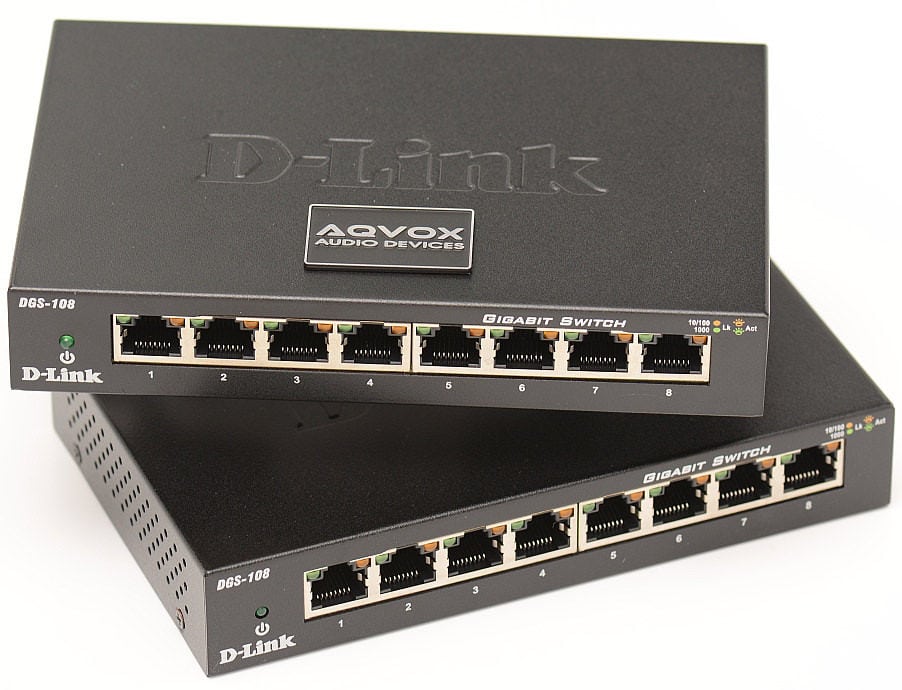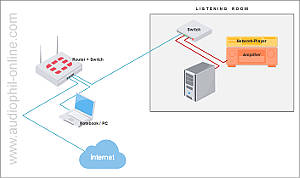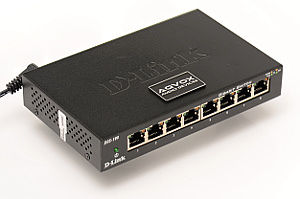Audiophile Data Distributor

Finally the days are over in which our domestic sound systems and computer networks live humbly apart from each other. Nowadays, audiophile communities increasingly enjoy high bit files which can conveniently be downloaded from the internet.
It goes without saying that digital music signals have to be channelled through network components. To date, computer components were hardly ever regarded as favourable from an audio perspective. That raises the question if or indeed how these components can have an impact on sound.
Contents:
- Introduction
- Switch – General
- Switch – AQVOX specifics
- Switch – Sound
- Sound Comparison
- Network – Thoughts
- Test Components
- Summary
- Sales & Prices
- Technology
- Tips
Switch – General
The switch is needed within a network in order to connect the individual network components together. In a private network, a device such as a network player could be connected to a NAS (Network Attached Storage) and/or to a router with internet access. This ensures that, within a netwerk segment, the individual frames reach their destination. In contrast to the very simple „Hub“ device-type, which supplies the frames to all ports, the switch makes its own forwarding decision. In this way, the frames are directly forwarded to their connected target-device.
Switch – AQVOX specifics
The AQVOX switch is a modified D-Link DGS-108. The robust metal housing boasts eight RJ45 ports with a transmission rate of up to 1,000 Mbps. Time-critical applications such as audio streaming are supported by the 802.1p protocol.
The components function without a fan and are therefore soundless. The switch is also easily installable in, for example, a domestic living room. The device works very economically according to the efficient Ethernet-Standard (IEEE 802.3az EEE); the ports only consume power during transmission.
The only distinction of the AQVOX modified device is the serial AQVOX sticker displayed on its exterior. The technical modifications are found internally within the wall plug transformer and the switch itself. AQVOX replaced the standard rectification components with ultra-fast diodes. They also lavishly refined the board from its usual manufactured remains and by doing so, unwelcome leakage currents from hydroscopic effects between the components are therefore prevented. The switch controller´s peripheral wiring was additionally optimized and important interference provisions against unwelcome, external high frequencies as well as internal jitters were also made.
Switch – Sound
Digital is digital – what do we need to change then? In order to be able to answer this question, we´ll need to take a look at the digital data material.
If an audio file is copied or downloaded from the internet then an error-free transmission using algorithms for error detection (e.g. by comparing checksums) will be guaranteed to the greatest possible extent. A corrupt frame will simply be transmitted once again.
By contrast, this is how it seems when audio streaming: The frames have to be transmitted in a relatively close time-lapse to the Digital Analogue Converter (DAC). If a frame is missing or a corrupt frame is received then a new frame transmission can in this instance, depending on the streaming protocol, be requested. When making a live-stream however, this is either limited or impossible due to time-constrained presettings.
The streaming protocols therefore have an error tolerance; if a poor transmission has occured then the following have to be reconstructed: up to a maximum of a five percent loss of inaudible frames and up to a ten percent of a loss of acceptable quality by an analogue signal projection (correction interpolation). However, from a sound perspective, an interpolation signifies a deterioration.
According to an algorithm test, error-free transmissions can also cause unpleasant sounds. „Jitters“ would be considered the keyword in this case. Each switch has a clock for the synchronized performance of digital assemblies. If the power supply is poor (in terms of voltage fluctuations and high-frequency superimpostions) then this has a negative impact on the clock rate: the digital audio data processing is not as time-precise and thus, causes jitters.
Sound Comparison
To cut a long story short: yes, there actually are switch-specific sound distinctions! Even customary switches, priced at around 20 euros are distinctively audible which we never expected. But step by step, let´s turn our attention once again to the AQVOX switch.
After some initial packet-provider distribution difficulties, the packet with two switches and special AQVOX-RJ45 cables arrived from the city of Hamburg. In order for us to be able to carry out a sound ramification evaluation on the AQVOX-developed tuning measures, the Hamburg sound specialist also sent us an untuned serial device. Additionally, we were recommended to swap over our currently used RJ45 standard connector to the AQVOX we were sent. We had no objections against doing so – up until now we had reprehensibly neglected the network cabling and were able to fathom a potential improvement. The cable exchange actually proved to be advantageous. Admittedly, there was no new sound dimension but it was nonetheless well-audible. With the new AQVOX cabling connected in a NAS – switch – network player form, the instruments created clearer contours whilst with the customary network cables, rather vague, undefined outlines tended to play.
The cabling task ended with a positive result. In order to enable both switches to function using the same operating conditions, we weren´t able to avoid phasing out the correct postioning of both networks´ mains plugs. The AQVOX switch as well as the basic device are harmoniously equipped with an earthing lug through which the phase out is easily determined by using a simple multimeter – (see Phase Out guide).
The work was crowned with success: the phase out made all components positively noticeable, even though the AQVOX switch didn´t respond that greatly to the correct mains plug position, in this case, to our Synology-NAS.
After these preliminary studies, the comparison between the DLINK DGS 108 and the tuned variants were able to begin. The first background music to play was performed by Hannah Köpf with „A Story Untold“ from her „Stories Untold“ album.
As soon as the untuned switch produced a boppy-sounding acoustic pattern, it enabled us to plunge rapidly into the depths of the music. However there was more: In direct comparison, the song and the tuning modification were both livelier and breezier. The one beforehand which was undefined, rippled and created a booming contrabass was now more clearly outlined and performed in a realistic magnitude. Where previously, the instruments played together on the virtual sound stage without a significant spatial boundary, the AQVOX switch then magically created „air“ between the performers. However the differences were considerably audible: In the Pops Hoedown (Richard Hayman) track, the AQVOX switch diplayed the strengths of the STEREO-listening CD VII very well indeed.
The brisk, american folk number with wildly muddled orchestrals played especially well by means of a well spaced out figure. It also came across very well with the untuned DLINK DGS 108 but with the AQVOX modifications was able to perform better. It caused a hidden sound-haze, which was found throughout the entire acoustic pattern, to disappear. Similar to a dirty pair of spectacles which, after a good cleaning means you can see through them clearly again. The performers were presented precisely on the sound stage, the violins lost artifical artefacts (sound errors) which by normal serial devices, creates a harsh undertone. Just like with the Hannah Köpf track, significant air between all performers was then created. This all adds up for a stress-free listening experience – despite the quick pace and surprising sound effects with a wide dynamic range.
The AQVOX switch therefore had to chose between both network components. However, one question still remains: what happens if you connect the NAS directly to the network player and subsequently bypass the switch? Technically speaking that would function perfectly well. However, from a sound perspective, a direct connection caused deterioration! As soon as the NAS and the network player were reconnected by the AQVOX, the sound stage opened up and the musical performance flowed closer to the listener.
How is that possible? Well, obviously the HF-anti-interference measures in the AQVOX switch make it positively noticeable. Just imagine that the switch from Hamburg serves as a filter which safeguards the network player from high-frequency interferences. The jittering could well be reduced by the switch.
Network – Thoughts

Where ideally, do you position a switch? Can you combine several switches? In the Audiophile Network article, we take a look at the sound-friendly network concept in more depth. For this test, we applied the concept in question successfully.
Test Components
- ASR Emitter 1 HD with Sonus Fiber Grand Piano Home
- Network player Pioneer N70-A with phonosophy-modification
- Synology DS 216Play with 2 x 2TB (approx. €475.00); further product details at amazon.de
- AQVOX High-End Ethernet-/Network Cable 1m (€162.00)
- AQVOX High-End Ethernet-/Network Cable 3m (€227.00)
- AQVOX AQ SWITCH-8 Gigabit Switch 8 Ports (approx. €398.00)
- D-Link Gigabit Network-Switch 8 Ports (approx. €25.00); further product details at amazon.de
- Netgear GS205 Gigabit 5 Port (approx. €15.00)
Summary
If you want to get the most out of a NAS & Co., be sure not to miss out on the currently unbeatable AQVOX switch. The added sound value of an AQVOX switch can be used to its full potential with a well customized system. With that in mind however, the basic tuning of a sound chain such as a phase-out, plug connection etc., should be carried out before anything. What´s also highly recommended is combining the the RJ45 cable with the modified switch in order to emit an especially good result.
The only (subjectively sensed) disadvantage, apart from the fact that quality costs money, is the front-facing connection terminal. If you position the cables in full view, it doesn´t look too pleasant – the cables would look better positioned on the rear-side of the device.
Sales and Prices

AQVOX AUDIO DEVICES
Steilshooper Str. 118
22305 Hamburg
Germany
Tel. +49-(0)40-410 068 90
Fax +49-(0)40-467 797 14
Email: [email protected]
Web: www.aqvox.de
Cost: Switch AQ-8: € 398.00, order online at www.myhifishop.de
Technology
- 1,000 Mbit/s – 1 Gigabit
- up to 1 Gbps bandwidth per port
- up to 2 Gbps bandwith in full-duplex-mode
- Cable diagnosis function
- Auto MDI/MDI-X crossover for all ports
- Plug & Play installation
- Protective metal housing
- Status LED´s for speed, active and lock
- Energy-saving operation
- Includes optimised power adaptor

